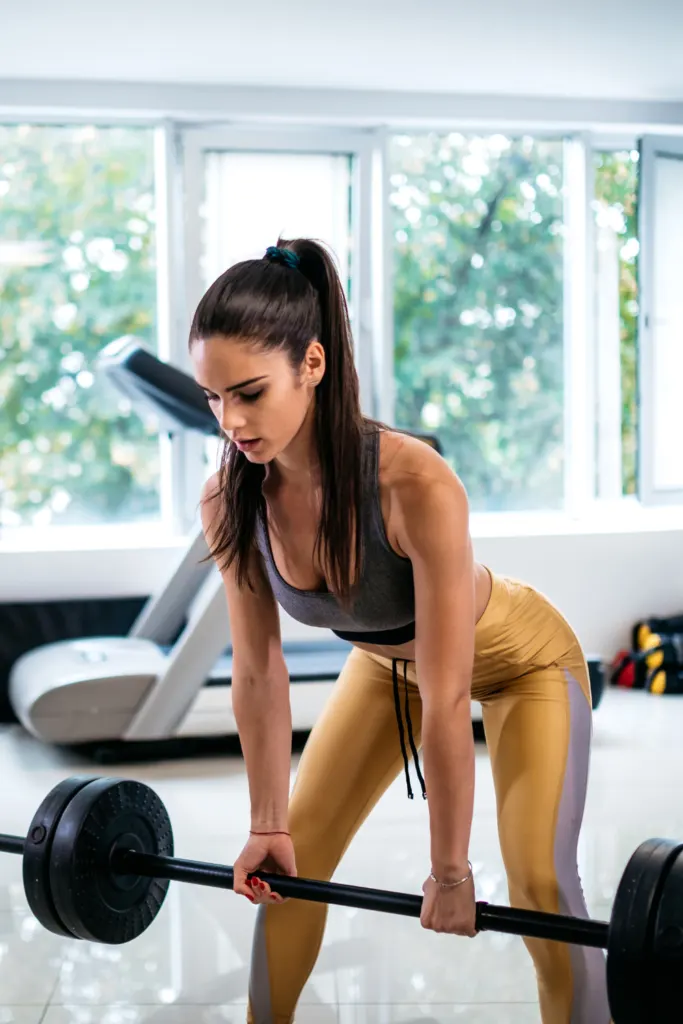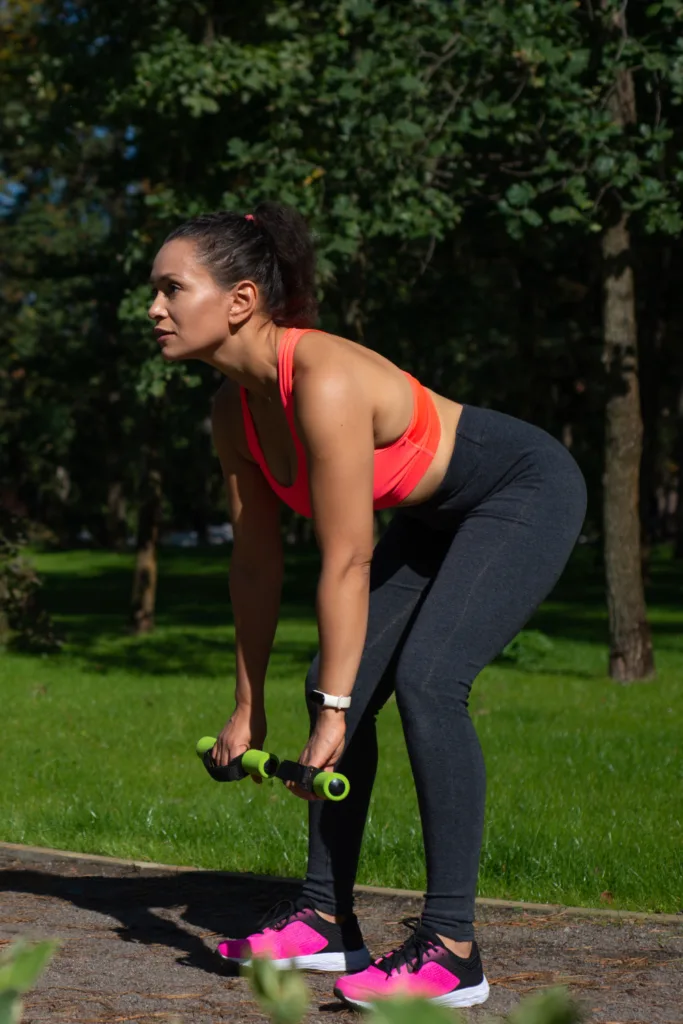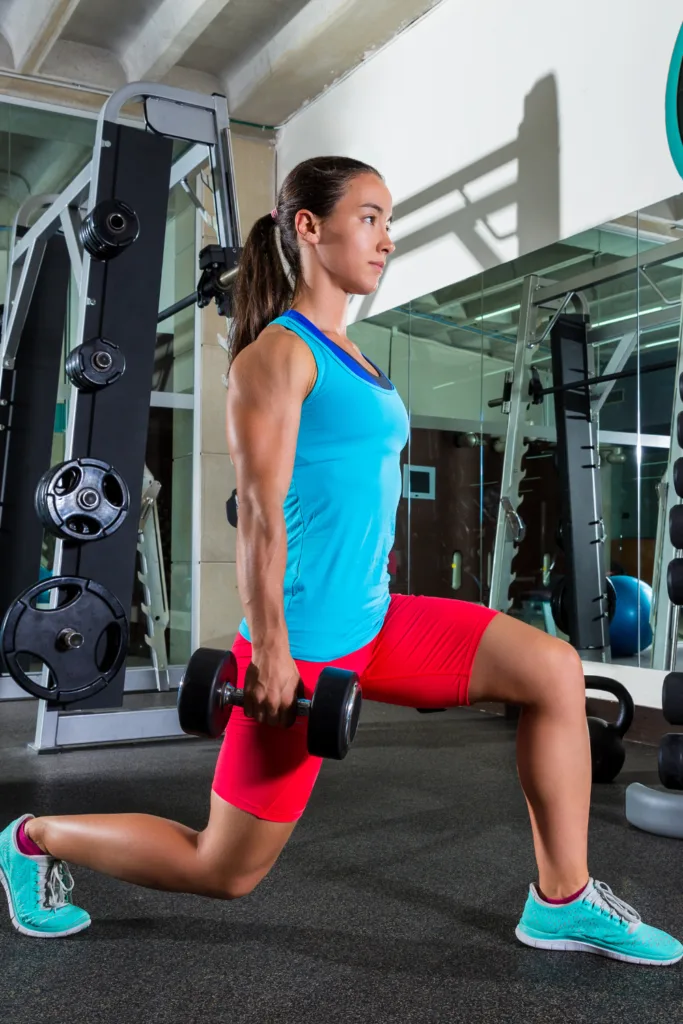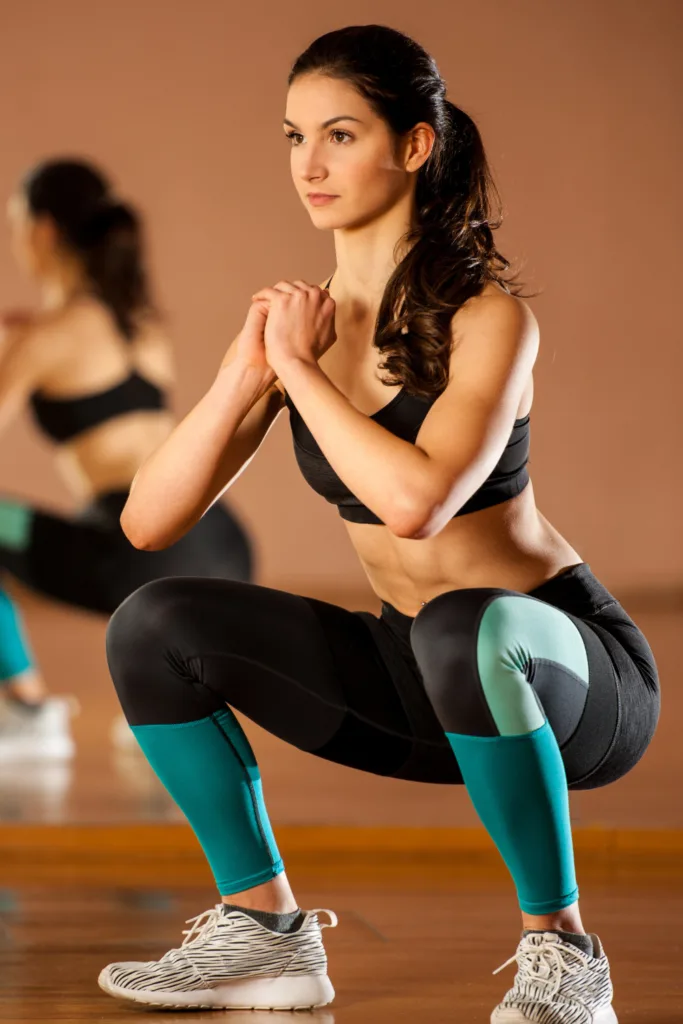If you’re looking to build stronger, thicker thighs, then you may be wanting to know how to get thicker thighs.
Our bodies come in different shapes and sizes – this applies to our thighs as well.
Your thighs and body in general will look different to someone else’s – after all it is what makes us all unique!
Arguably, strong and defined thighs are an indicator of strength and time spent at the gym.
There’s no doubt that a pair of ‘thicc’ thighs can add a lot to your physique – but what exactly are the advantages of having thick thighs? And how do you get bigger, thicker thighs?
In this guide we’ll look at:
- What is the thigh?
- What are the muscles in the thighs?
- What influences thigh size?
- What are the benefits of having bigger thighs?
- What is the perfect thigh size?
- How to measure your thighs
- How to get thicker thighs
- 5 leg workouts to increase thigh size
Ready?
Let’s go!

What is the thigh?
The thigh is the upper leg area that sits between the hip and knee joint.
There is a single bone in the thigh called the femur, which is split into three main segments:
- Proximal end – the attachment sites for the hips, pelvis and thigh
- Shaft – the cylindrical shaft of the femur
- Distal end – the attachment site to the knee
The thigh bears a lot of the load of your body weight when you’re standing upright.
It contains many muscles and nerves, as well as fat and connective tissue.
Related: Does running build leg muscle? 4 leg workouts for runners
What are the muscles in the thighs?
The main three muscles that are found in the thigh are:
- Adductors in the inside of the thigh
- Hamstrings in the back of the thigh
- Quadriceps in the front of the thigh
The quads and hamstrings work together to straighten and bend the leg and knee.
Whereas the adductor muscles pull the legs together inward towards each other.
The glutes – although technically in the buttocks – work closely with your thigh muscles to help with hip abduction and extension.
Related: Heavy legs when running: 9 causes + how to prevent it

What influences thigh size?
Your thigh structure is determined by the following factors:
- Your bone structure
- The distribution of body fat in your thighs and buttocks
- The distribution of muscle mass in your thighs and buttocks
- Your hormone levels
As we explained above, the thigh contains several muscles which allow your lower body to bend, rotate and flex.
These muscles also help to keep your hips and legs aligned and balanced.
Thigh muscles attach to the thigh bone (femur) with tendons. The femur is the largest and strongest bone in the human body.
The amount of fat and muscle mass in your thighs will depend on your genetics and hormone levels.
Depending on your body type, you may or may not store more fat in and muscle in your thighs and buttocks compared to other areas of your body.
- If you are pear-shaped, you will likely store more fat in your thighs and buttocks.
- If you are apple-shaped, you will store more fat in your abdomen and stomach.
You cannot choose where you store fat in your body, but you can determine the size of your thigh muscles by building muscle through diet and exercise.
When it comes to hormones, if you have higher estrogen levels, you will likely store more fat in your thighs and buttocks.
This is because estrogen increases fat storage overall, especially in the upper arms, buttocks and thighs.
Estrogens are groups of hormones that play a key role in reproductive development and regulating the menstrual cycle in women.
In addition, they affect the urinary tract, heart and blood vessels, bones, breasts, skin, hair, pelvic muscles and the brain.
Related: The ultimate 30 day strength training plan for runners
What are the benefits of having bigger thighs?
There have been various studies that have looked at the link between larger thighs and general health and wellbeing.
According to a 2009 study, a low thigh circumference seems to be associated with an increased risk of developing heart disease or premature death.
The study adds that thigh size may help doctors to early identify an increased risk of premature death.
Before you get worried and hit the gym every day, it’s important to note that the study was conducted on a small group of participants and requires further research and exploration.
Interestingly, some other studies have shown the links between leg power, cognitive function and IQ.
This means that stronger legs can lower the risk of cognitive diseases like dementia and Alzheimer’s disease.
Related: 7 of the best glute strength exercises for runners

What is the perfect thigh size?
Thigh size is dependent on a variety of factors, including your age, gender, genetics and fitness goals – so there really isn’t a perfect thigh size.
Some people prefer thin legs while others prefer thicker legs and heavily defined muscles.
Anthropometric reference data exists from the Centre for Disease Control (CDC) which tells us what mid-thigh circumference should be in accordance with age.
Whilst we can’t give you exact thigh size measurements, this data provides a good indication of thigh size in both males and females.
Here are the statistics for females aged 20 years of age and older:
| Age | Mean thigh size | Thigh size range |
| 20-29 years old | 52.9cm | 42.2cm – 69.1cm |
| 30-39 years old | 54.2cm | 44.0cm – 68.8cm |
| 40-49 years old | 54.4cm | 43.7cm – 70.2cm |
| 50-59 years old | 53.2cm | 43.1cm – 66.0cm |
| 60-69 years old | 52.2cm | 40.2cm – 62.0cm |
| 70-79 years old | 49.6cm | 40.2cm – 62.0cm |
| 80 years and over | 47.5cm | 38.2cm – 56.8cm |
Here are the statistics for males aged 20 years of age and older:
| Age | Mean thigh size | Thigh size range |
| 20-29 years old | 55.1cm | 45.4cm – 68.6cm |
| 30-39 years old | 55.1cm | 46.7cm – 65.0cm |
| 40-49 years old | 55.0cm | 46.8cm – 65.0cm |
| 50-59 years old | 53.2cm | 44.4cm – 63.1cm |
| 60-69 years old | 51.9cm | 43.7cm – 60.9cm |
| 70-79 years old | 50.0cm | 42.7cm – 58.5cm |
| 80 years and over | 46.6cm | 39.5cm – 54.2cm |
Related: 6 simple strength exercises for runners
How to measure your thighs
Now you know more about the ideal thigh size, here are steps that show you how to measure your thigh size.
All you need is a tape measure!
- Stand up straight in a relaxed position and make sure your weight is distributed evenly across both feet.
- Find the mid-point between your hip and knee – this is the point between your hip bone and top of your knee bone.
- Wrap the measuring tape around this mid-point and check the measurement.
- Take the measurement twice to check that it’s accurate.
Related: Weightlifting for runners: 5 reasons to take up weightlifting as a runner
Thigh size Q&A
Q: Can the bone and muscle in your thighs affect how you perform certain exercises?
A: The femur length can affect how you perform certain exercises like squats and deadlifts.
According to strength and conditioning coach Brett Contreras, squat mechanics are highly influenced by anatomy and anthropometry.
Your torso and femur proportions will affect your squat form:
- If you have a shorter femur bone, you will find it easier to stay upright and go deeper when squatting.
- If you have a longer femur bone, you will have a greater forward lean when you squat and go just below parallel.
Q: Can you get thicker thighs without exercise?
A: As we explain later in this guide, strength training is key to build muscle.
However, there are ways you can get thicker thighs without exercise, as long as you move and work your muscles in different ways.
For example, instead of going to the gym for a leg workout, you could go for a walk, do some gardening, ride your bike or play with your kids.
Arguably, a demanding play session with your kids involves a lot of squatting and lifting and can be just as intense as a leg workout!
Related: Hip pain after running: 8 causes + how to fix it

How to get thicker thighs
How to get thicker thighs?
This comes down to two key things: eating right and strength training.
#1 Eat right
If you’re looking to get bigger, thick thighs, then the first thing you’ll want to address is your diet and calorie intake.
You’ll need to eat a calorie surplus – that is eating more calories than you burn through movement and exercise – in order to increase the size of your thighs.
You may remember earlier in this guide we told you that you cannot govern how and where your body stores fat.
Like it or not, your genetics will determine where you store fat – including in your thighs.
But before you reach for the next carb-rich meal, it’s important you get enough protein each day.
The general recommendation is to consume between 0.6 – 0.9 grams of protein per pound per day.
It’s important to note that no single food or meal will help you get bigger thighs – instead you should focus on eating a calorie surplus each day by eating healthy, wholefoods.
This means avoiding foods that are highly processed or high in refined carbs and sugar.
#2 Strength train
Along with your diet, you need to be doing strength training exercises in order to increase the size of your thigh muscles.
These strength training exercises should target the muscles in your thighs – that is your hamstrings, quadriceps and adductors as well as your glutes.
You should aim to do at least 2 to 3 strength training workouts per week to really see results.
In addition to this, you should use the principles of progressive overload in order to promote muscle growth.
If you do the same workout over and over and use the same amount of weight every time you will unlikely see any progress.
And remember, your ability to increase muscle mass is highly dependent on your genetics – so your results won’t necessarily be the same as someone else’s.
Thighs come in all shapes and sizes! The key is to appreciate function over aesthetic.
#3 Drink enough water
Your muscles are made up of about 80% water.
Dehydration can impair your ability to gain muscle, so it’s important you stay hydrated, especially when you have a demanding training routine.
Related: 5 dynamic hip flexor stretches for runners + how to do them

5 leg workouts to increase thigh size
Here are 5 leg workouts to increase thigh size.
When performing these exercises, it’s important you follow the principles of progressive overload – as explained earlier – to really see results in muscle growth.
So, for example, in week 1 you could perform 10 reps at one weight. Then in the next week, you could perform 12 reps but increase the weight.
Workout 1: Bodyweight leg workout
In this workout you’ll be using your own bodyweight as the resistance. As such, this workout is great for beginners.
Perform 2-3 sets of 8-12 reps using your own bodyweight.
- Air squat
- Forward lunge
- Lateral lunge
- Bulgarian split squat
- Reverse lunge
Workout 2: Dumbbell leg workout
In this workout you’ll be using a dumbbell as the resistance.
When it comes to weight, we recommend you pick a weight that you are comfortable with – typically between 4kg to 8kg.
Perform 2-3 sets of 8-12 reps.
- Goblet squat
- Forward dumbbell lunge
- Romanian deadlift with dumbbells
- Bulgarian split squat with dumbbells
- Dumbbell step up
Workout 3: Barbell leg workout
In this workout you’ll be using a barbell.
While barbells are traditionally used to work the arms and chest, they are great for the legs too.
Again, when it comes to weight, only use a barbell weight that you are comfortable using.
Perform 2-3 sets of 8-12 reps.
- Barbell squat
- Barbell deadlift
- Walking lunges with barbell
- Good mornings
- Barbell glute bridge
Workout 4: Plyometric leg workout
A plyometric workout involves exercises in which muscles exert maximum force in short intervals.
The goal of a plyometric workout is to increase power and improve performance.
Perform 2-3 sets of 8-12 reps.
- Front box jumps
- Side box jumps
- Scissor jumps
- Lateral skater jumps
- Weighted lateral jumps
Workout 5: Cardio leg workout
Whilst it’s true strength training exercises should be the focus of your workouts, there are also cardio exercises that you can do to increase leg power and muscle size.
The key is to challenge your muscles in different ways by turning up the tension.
This could either be selecting a demanding workout or increasing the resistance of the machine.
- 10 minutes stationary cycle
- 10 minutes stair climbing
- 10 minutes treadmill running
Related: Does running build leg muscle? 4 leg workouts for runners
- 5 things I wish I’d known before returning to running - March 3, 2024
- Running 20 minutes a day: Benefits + how to start - January 27, 2024
- How to run your first 2 hour half marathon - January 16, 2024
